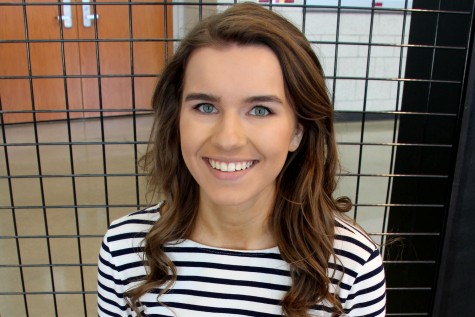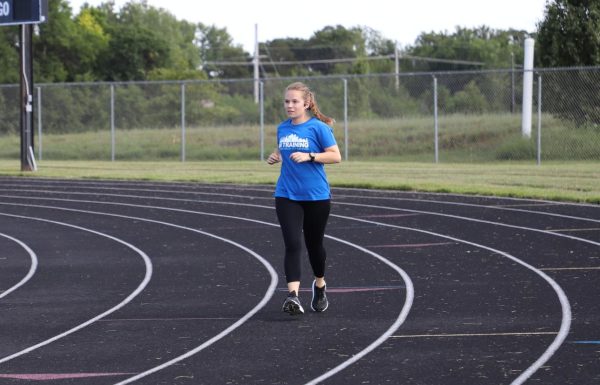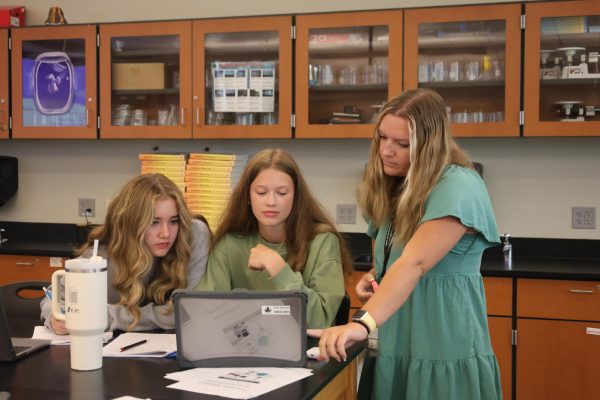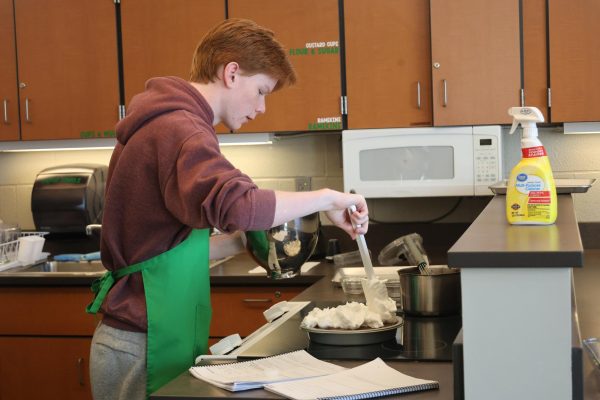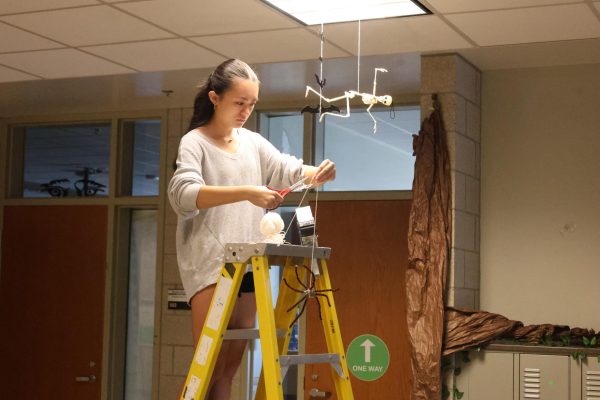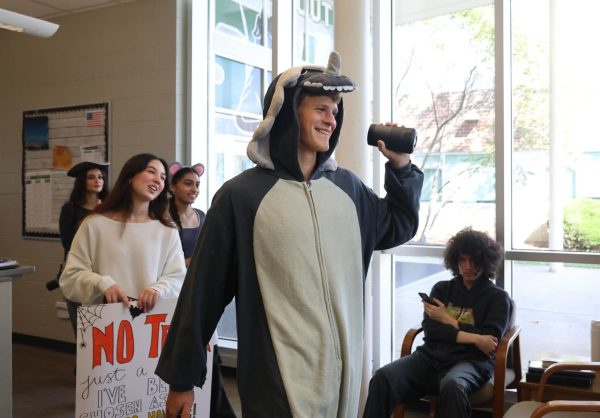Parents of students with special needs share how their children will transition into their lives after high school
When Becca Dopheide returns home from work every evening, her focus immediately turns toward her daughter Julia. She cooks her dinner, cutting up each bite and watching to make sure Julia’s food makes it into her mouth and not on the floor. Becca keeps a close eye on the kitchen – as Julia is in the mouthing stage, nothing, from the bananas to the coffee pods, is off limits. If she starts to cry, she can’t tell her mom why she’s upset, but Becca usually takes her on a walk to calm her nerves. At 7:15 p.m., she takes Julia upstairs for her bath, brushes her teeth, dresses her in her pajamas, and by 8 p.m., Julia is asleep. This has been Julia’s life every night for the past 17 years — and possibly for the rest of her life.
Julia has a rare degenerative disease known as Sanfilippo syndrome. In most brains, a specific enzyme breaks down a complex sugar in order to prevent it from building up in the brain cells. But Julia is missing this enzyme, and as the complex sugar continues to build up in her brain, it progressively causes neurological damage. While she was once able to say simple phrases, within the past two years, Julia has completely lost her ability to verbally communicate. And while she is still able to run and walk, she has gradually become less and less mobile.
“She doesn’t sing as much, and she won’t engage with many toys,” Becca sad. “Sometimes I can get her to laugh, but she used to laugh all the time. With this disease, it’s really weird because I’ll look back to six months ago and go, ‘Oh, Julia used to be able to stand up and get out of the bathtub by herself, and she can’t do that anymore. When did she stop doing that?’ You don’t realize it, but all of a sudden another skill is gone.”
Julia was diagnosed with the syndrome a month before her third birthday. When she was born, she had mild gastrointestinal problems and her sleep patterns weren’t consistent, but this was nothing that made Becca and Julia’s father, Andy, think that Julia was suffering from anything more serious than the common hiccups in an infant’s life.
But at 18 months, Julia’s developmental rate was considerably behind — she couldn’t put two words together, she never slept a whole night, and she couldn’t digest food. Andy and Becca took Julia to a sleep doctor, who noticed that Julia’s symptoms were more than what could be cured by sleep therapy.
At the suggestion of the sleep doctor, they visited a geneticist, who completed four tests on Julia’s bloods. To Becca and Andy’s relief, the first three tests came back negative for the various syndromes they were tested for. But the fourth test, which tested the most most serious diseases, came back positive, and Julia was diagnosed with Sanfilippo syndrome. The geneticist then told Becca and Andy that the disease was incurable, there were no treatments available and that Julia would live to be, at most, 15 years old. This was a life-changing moment that would make Julia’s family appreciate every day that she’s alive.
“If I let myself think about it, I would go into the corner and curl up and not function — but I don’t want to do that,” Becca said. “If I hear [Julia] in her room, or if I go in there and she’s awake, I just say a thank-you prayer to God that I have another day with her.”
But as the grieving stage passed, the acceptance that Julia would be living with a life-threatening disease sunk in. Becca entered Julia in occupational, physical and speech therapy, and they attended a Mommy and Me preschool for students with special needs. When she moved to Overland Park at eight years old, Julia enrolled in the Blue Valley district and was put in a program at her elementary school for students with special needs.
Julia continued the program throughout middle school, where she was taught how to complete simple communication and vocational skills. As high school approached, Becca was introduced to the Severe Multiple Disabilities (SMD) program, which is the program unique to Southwest that is designed to cater to the needs of students with the most severe medical and intellectual disabilities in the district.
Through the SMD program, Julia focuses on goals set on her Individual Education Plan (IEP), a personalized document for all students with special needs in the district that outlines goals that the student is supposed to work toward each year. Because Julia suffers from a degenerative disease, her parents, SMD teacher Marilyn Foerster and transition specialist Cathy Jewell set vocational and speech goals for Julia to work on to maintain her functioning level. Throughout her school day, Julia also attends specialized gym and art classes for students with special needs, while also being given time to relax.
“When you’re preparing IEPs, you’re always looking at goals increasing what [the kids] can do over the next year, and with Julia, early on, it was hard to get some of her teachers to understand that we’re not looking for growth, per se, because we’ll never meet those goals,” Becca said. “We’re looking to maintain as much as possible and keep her functioning at this level as long as we can.”
The SMD program focuses not only on the students’ goals for the school year, but also on teaching students daily life skills that can be applied once the students graduate the program. The SMD program shares a room called ‘the apartment’ with the students in the Intensive Resource (IR) program, taught by Brooke Claypool. The apartment features a kitchen where students learn how to cook simple meals and perform daily kitchen duties, as well as a washer and dryer that students use when learning how to complete tasks such as sorting laundry.
“For every individual you want them to be as self-sufficient as possible,” Foerster said. “For my SMD students, my main goal for them every day is that they’re safe, and then once I know they’re safe, my goal is that they’re engaged in their day and they’re treated with respect. They [need to] feel that they’re with people during the course of the day that show them care and respect and, to some degree, love.”
In the special education classes, students work with peer tutors, who are general education students that assist students with special needs in achieving the goals set on their IEPs. Peer tutors also work with Claypool, Foerster and other paraprofessionals to assist students in the SMD and IR programs with their core curriculum classes that teach them reading, math and science skills that can be applied to their lives after graduation. Foerster said that a benefit of having peer tutors in special education classes is that they provide students with special needs the interaction with general education students that they wouldn’t get elsewhere.
“The biggest impact [that the peer tutors have on special education students] is that it allows children with special needs to have friends — that’s one of the greatest issues for any child or student who has any kind of special need,” Foerster said, “I see my students’ faces light up when they see somebody they know, like when a peer comes in the room or when we’re walking down the hall.”
Claypool said that interaction with peers in general education classes is important not only because it lets students with special needs form friendships, but also because it teaches them to interact with the people who will potentially be their employers. But for students with special needs, those opportunities after high school are slim. According to SpecialNeedsPlanning.net, 75 percent of people with special needs are unemployed. Jewell takes into account matters of employment as well as finding other post high school opportunities when working with parents at annual IEP meetings.
“It’s very difficult for [students with special needs] because here in the school district, [students] get very good services, and it is very hard once that ends and there’s nothing and they’re home,” Jewell said. “Both parents work, the mother or father may have to quit so there’s somebody to stay home with their young adult because there’s nowhere to put them because there’s no funding.”
The lack of funding for programs supporting people with special needs has created a difficult situation for parents. In recent years, the federal government has allocated a decreased amount of funding to special needs programs that support students after they turn 21. This lack of funding trickles down to the state level governments and eventually makes its way to the local governments that supply parents with services such as caretakers and medical supplies, as well as provide support for residential communities for people with special needs. The waiting list for parents to receive these services has increased to five to six years on average.
Because of her family situation and the severity of Julia’s special needs, Becca was able to work with a caseworker, who helped her apply for crisis funding and surpass the five to six year waiting list. Shortly after applying for crisis funding, Becca was approved and put into the government system, which provides Becca with caretakers, as well as supplies for Julia.
Due to the severity of her disease, Julia won’t be able to attend schooling past high school or apply for a job. The district guarantees students with special needs school services until they turn 21. Becca currently plans on keeping Julia in the SMD program at Southwest until she turns 21, and then she will live at home with the help of caretakers. But with the severity of her condition, Becca said that Julia’s plans could change a year from now, depending on her functioning level.
“For Julia, I would never want her to feel any pain,” Becca said. “I don’t worry about anything else because she’s always going to be with me, [but] I just want to take care of her until the end.”
While some parents, like Becca, are able to receive governmental aid rapidly because of their child’s unique medical and living situations, other parents aren’t as fortunate. Paraprofessional Deb Newell is working to prepare her son who has autism, senior Ben Newell, for the daily duties of his life once he graduates and gets on the waiting list for governmental services.
Deb and her husband Scott noticed when Ben was six months old that he wasn’t developing at the same rate as his older sister. He never slept more than two hours at a time, and he had difficulty digesting his food. When he was diagnosed at two years old, Deb said that she found relief after dealing with the frustrating process of getting doctors to finally acknowledge that what Ben was experiencing wouldn’t cease with time, but that his diagnosis also made her family realize that Ben would need support for the rest of his life.
“I think when a child first gets diagnosed, there’s a grieving process that parents go through because even though you still love your child a lot, you have to accept that whatever hopes and dreams you had for your child will be different than what you thought,” Deb said.
Through the IR program, Ben also has been a part of the Blue Valley Career Development Opportunities Program (CDOP), which has allowed him to explore different job opportunities. During students’ junior and senior years, they rotate through four businesses — a bakery, a greenhouse, a green planted awareness program and a light industry manufacturer — in order to find a career path that may be suitable for them.
Now in his last rotation, Ben spends two hours a day working at the greenhouse at the CDOP building, located in the District Office complex. He then returns to the IR classroom where he learns daily living skills with the assistance of paraprofessionals and peer tutors.
“[Ben] feels more comfortable moving throughout the school than when he first got here and even during middle school,” Deb said. “He feels comfortable here, and he feels safe and accepted.”
When Ben graduates, he will attend the Blue Valley Adult Cooperative Community Education Services and Support program. Jewell founded the program to provide students with special needs a place to learn daily living activities and job skills in order to find employment upon exit services — and to also prepare for life during the five to six year wait list for services. Ben also has plans to attend some non-degree seeking services at Johnson County Community College.
“You always want your child to be involved and have something purposeful to do, and we don’t want [Ben] to just be sitting at home with nothing to do being bored,” Deb said. “He needs something to keep him engaged and to keep his mind active and keep him around other people.”
Special education programs are far from where they once were a few decades ago, when students with special needs were kept completely isolated from the general education student body. But Claypool said that society can still do more to help students exiting school services find acceptance during their transition into society.
“For so many years, individuals with disabilities had a stereotype that hovered over them, and now as a whole, I feel like we’re overcoming that, but there’s still lots of obstacles,” Claypool said. “I think we just have to continue breaking through some barriers to get it to where we see employment. There are so many more places that we can start with getting that acceptance and hiring.”


